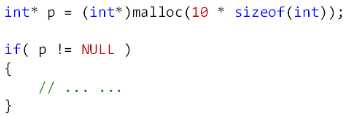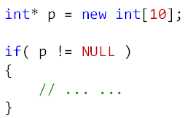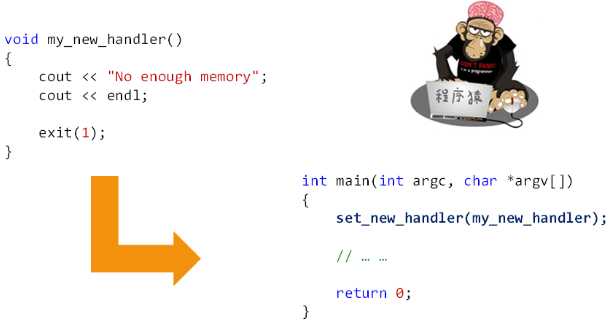标签:移植 函数 warning ++ 参数 effect size 常见 har
问题:
动态内存申请一定成功吗?
常见的动态内存分配代码:
C代码:

C++代码:

必须知道的事实!
问题:
new语句中的异常是怎么抛出来的?
new关键字在C++规范中的标准行为:
new_handler() 的定义和使用:

问题:
如何跨编译器统一 new 的行为,提高代码移植性?
解决方案:
示例1——证明存在 new_handler() 函数:
#include <iostream>
#include <cstdlib>
using namespace std;
class Test
{
int m_value;
public:
Test()
{
cout << "Test()" << endl;
m_value = 0;
}
~Test()
{
cout << "~Test()" << endl;
}
void* operator new (unsigned long size)
{
cout << "operator new: " << size << endl;
// return malloc(size);
return NULL;
}
void operator delete (void* p)
{
cout << "operator delete: " << p << endl;
free(p);
}
void* operator new[] (unsigned long size)
{
cout << "operator new[]: " << size << endl;
return malloc(size);
}
void operator delete[] (void* p)
{
cout << "operator delete[]: " << p << endl;
free(p);
}
};
void my_new_handler()
{
cout << "void my_new_handler()" << endl;
}
void ex_func_1()
{
new_handler func = set_new_handler(my_new_handler);
try
{
cout << "func = " << func << endl;
if( func )
{
func();
}
}
catch(const bad_alloc&)
{
cout << "catch(const bad_alloc&)" << endl;
}
}
int main(int argc, char *argv[])
{
ex_func_1();
return 0;
}运行结果为:
[root@bogon Desktop]# g++ test.cpp
test.cpp: In static member function ‘static void* Test::operator new(long unsigned int)’:
test.cpp:28: warning: ‘operator new’ must not return NULL unless it is declared ‘throw()’ (or -fcheck-new is in effect)
[root@bogon Desktop]# ./a.out
func = 0(在g++编译器中没有设置这个全局的 new_handler() 函数,bcc编译器中实现了这个全局的 new_handler() 函数。)
示例2——动态内存申请失败的结果:
#include <iostream>
#include <cstdlib>
using namespace std;
class Test
{
int m_value;
public:
Test()
{
cout << "Test()" << endl;
m_value = 0;
}
~Test()
{
cout << "~Test()" << endl;
}
void* operator new (unsigned long size)
{
cout << "operator new: " << size << endl;
// return malloc(size);
return NULL;
}
void operator delete (void* p)
{
cout << "operator delete: " << p << endl;
free(p);
}
void* operator new[] (unsigned long size)
{
cout << "operator new[]: " << size << endl;
return malloc(size);
}
void operator delete[] (void* p)
{
cout << "operator delete[]: " << p << endl;
free(p);
}
};
void ex_func_2()
{
Test* pt = new Test();
cout << "pt = " << pt << endl;
delete pt;
}
int main(int argc, char *argv[])
{
ex_func_2();
return 0;
}运行结果为:
[root@bogon Desktop]# g++ test.cpp
test.cpp: In static member function ‘static void* Test::operator new(long unsigned int)’:
test.cpp:28: warning: ‘operator new’ must not return NULL unless it is declared ‘throw()’ (or -fcheck-new is in effect)
[root@bogon Desktop]# ./a.out
operator new: 4
Test()
Segmentation fault (core dumped)(g++编译器中报错:段错误。不同的编译器报错信息不同。)
示例3——统一不同编译器动态内存申请失败后的行为:
#include <iostream>
#include <cstdlib>
using namespace std;
class Test
{
int m_value;
public:
Test()
{
cout << "Test()" << endl;
m_value = 0;
}
~Test()
{
cout << "~Test()" << endl;
}
void* operator new (unsigned long size) throw()
{
cout << "operator new: " << size << endl;
// return malloc(size);
return NULL;
}
void operator delete (void* p)
{
cout << "operator delete: " << p << endl;
free(p);
}
void* operator new[] (unsigned long size) throw()
{
cout << "operator new[]: " << size << endl;
// return malloc(size);
return NULL;
}
void operator delete[] (void* p)
{
cout << "operator delete[]: " << p << endl;
free(p);
}
};
void ex_func_2()
{
Test* pt = new Test();
cout << "pt = " << pt << endl;
delete pt;
pt = new Test[5];
cout << "pt = " << pt << endl;
delete[] pt;
}
int main(int argc, char *argv[])
{
ex_func_2();
return 0;
}运行结果为:
[root@bogon Desktop]# g++ test.cpp
[root@bogon Desktop]# ./a.out
operator new: 4
pt = 0
operator new[]: 28
pt = 0显示的调用析构函数
示例4——让编译器申请失败后返回空指针而不是抛出异常:
#include <iostream>
#include <cstdlib>
using namespace std;
class Test
{
int m_value;
public:
Test()
{
cout << "Test()" << endl;
m_value = 0;
}
~Test()
{
cout << "~Test()" << endl;
}
void* operator new (unsigned long size) throw()
{
cout << "operator new: " << size << endl;
// return malloc(size);
return NULL;
}
void operator delete (void* p)
{
cout << "operator delete: " << p << endl;
free(p);
}
void* operator new[] (unsigned long size) throw()
{
cout << "operator new[]: " << size << endl;
// return malloc(size);
return NULL;
}
void operator delete[] (void* p)
{
cout << "operator delete[]: " << p << endl;
free(p);
}
};
void ex_func_3()
{
int* p = new(nothrow) int[10];
// ... ...
delete[] p;
int bb[2] = {0};
struct ST
{
int x;
int y;
};
ST* pt = new(bb) ST(); // new():在指定空间上创建对象
pt->x = 1;
pt->y = 2;
cout << bb[0] << endl;
cout << bb[1] << endl;
pt->~ST(); // 显示的调用析构函数
}
int main(int argc, char *argv[])
{
ex_func_3();
return 0;
}运行结果为:
[root@bogon Desktop]# g++ test.cpp
[root@bogon Desktop]# ./a.out
1
2实验结论:
标签:移植 函数 warning ++ 参数 effect size 常见 har
原文地址:https://www.cnblogs.com/PyLearn/p/10104322.html